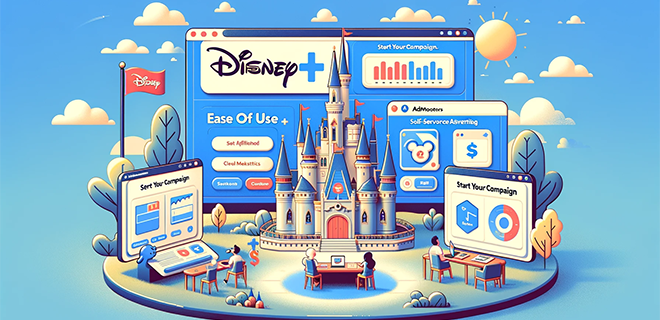
The iconic entertainment conglomerate prioritizes self-service automation to aid its agency and brand partners with transparency, accessibility, real-time measurement, and optimization.
At a time when more competition exists amongst streaming media services, Disney Advertising landed on a strategy to accelerate access to Disney+ AVOD inventory when the publisher launched its Disney Campaign Manager.
In 2023, over 4,500 advertisers and 1,000 agencies transacted on Disney Campaign Manager, with many of those brands being first-time streaming advertisers.
 For long-standing SVOD-only publishers, the switch to AVOD, or a hybrid model, has begun to pay off.
For long-standing SVOD-only publishers, the switch to AVOD, or a hybrid model, has begun to pay off.
According to Insider Intelligence/eMarketer, the Disney+ ad-supported streaming option will hit $786.6 million in advertising revenue for 2023 — somewhat higher than the $684.6 million projected for Netflix’s advertising tier. Given that Disney+ has only been operating as a hybrid model for a year, these numbers are impressive.
It’s also clear that viewers, suffering from subscription fatigue, are embracing a TV-like ad experience with ads interspersed throughout their content.
In October, Disney reported that 50% of new subscribers are choosing the ad-supported version of Disney+. An ad-supported tier greatly reduces the subscription cost for consumers, but it also creates a more lucrative business for publishers.
While programmatic is driving much of CTV’s growth, direct deals play a critical in the shift from SVOD to AVOD. Direct provides the best opportunity for publishers to nourish a client-first experience and provide white-glove service, establishing strong relationships with buyers while laying the bricks for data-enabled transactions like PMPs.
On one level, that’s exactly what self-service platforms like Disney’s Campaign Manager provide buyers. It offers premium inventory, campaign management, reporting, and optimization.
“It involves cultivating essential relationships with advertisers and positioning publishers to optimize the monetization of their ad-supported content effectively,” said Yaka Brownlee-Yamaguchi, Director of Customer Success at Disney Advertising.
Securing Incremental Ad Spend with Self Service
For most publishers, it’s not cost-efficient for sales to go through the traditional contract process for transactional or smaller transactions. This makes self-service tech appealing for providing workflow efficiency and capturing incremental revenue.
Disney’s Campaign Manager offers buyers flexibility and accessibility, leading to more frequent transactions and incremental spend.
 “The platform empowers clients with autonomy and control over their purchasing journey. This grants them independence regarding making decisions on timing and method of procurement,” said Ella Leung, Director of Self Service Platform Sales at Disney Advertising.
“The platform empowers clients with autonomy and control over their purchasing journey. This grants them independence regarding making decisions on timing and method of procurement,” said Ella Leung, Director of Self Service Platform Sales at Disney Advertising.
“Clients benefit from accelerated time-to-market, wherein campaigns are planned, constructed, booked, and launched within days, eliminating potential delays associated with direct IOs.”
According to Leung, self-service provides a more personalized experience and turnkey campaigns while clients manage their business independently; it allows buyers to leverage data analytics and customer insights to offer personalized recommendations. As the customer base grows, so does the potential for capturing incremental spend.
Self-Service, a Safe Haven for SMBs
For far too long, the duopoly of Meta and Google has garnered the lion’s share of SMB spend. Many SMBs don’t have the budgets required to get in front of a premium publisher’s audience, and self-service tech helps publishers capture some of that spend.
Self-service advertising platforms have taken off over the past few years with retailers like Walmart and Amazon joining the ranks, as well as social media networks like Snapchat and TikTok, travel platform TripAdvisor, and several publishers like Hearst, Hulu, Soundcloud, Spotify, The Washington Post, and Vox. Self-service platforms are built for simplicity and speed, providing user-friendly interfaces that are easy to use, even for buyers with limited resources or technological backgrounds.
“Self-service has a lower barrier to entry, so it helps level the playing field between SMBs and national brands,” said Brownlee-Yamaguchi. “It can help amplify the brand and reach consumers, and self-service also drives results with automation. Advertisers can set their budgets, allowing them full control over their spending and the ability to allocate resources based on their budget. They can also target niche audiences or specific demographics to maximize the impact of their campaigns.
The platform provides a seamless way for CTV publishers to connect with brands with smaller budgets. “Our self-service platform offers affordability, user-friendly interfaces, customization options, automation, targeted advertising, real-time analytics, direct access to inventory, transparent pricing, and educational resources on reaching targeted audiences effectively,” Brownlee-Yamaguchi added.
Getting Started with Self-Service
For buyers, transitioning to self-service — or just starting — might come with some hiccups. Common drawbacks might include the uncertainties of competitive marketplace challenges, navigating platform updates, and clearly understanding a publisher’s intricacies.
Leung encourages brands unfamiliar with self-service not to hesitate to test and learn. Getting started can feel daunting, especially if a buyer is new to investing in media or a streaming strategy, so starting with a hybrid approach is best.